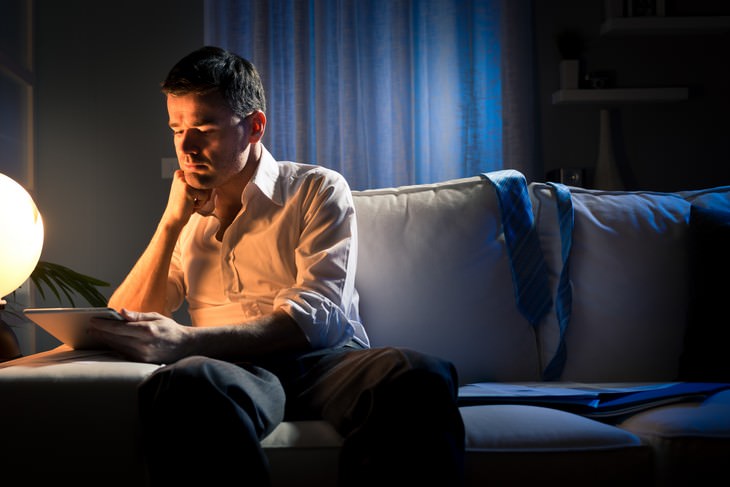What is Blue Light and How Does it Affect Us?
The color blue generally has positive,
calming associations - clear skies, the sea, natural light. But in
recent years there's been an influx of blue light coming from a
different source, which we are all exposed to in varying degrees - the
blue LEDs emitted from our phones, computers, tablets, and TV screens.
You may have heard about the negative impacts screen time has on sleep
and fatigue (lack of sleep in itself may contribute to the causation of
other health concerns like obesity, diabetes, etc).
But what’s in those lumens that could
affect our bodies that way? It mostly has to do with the body’s
biological clock or the circadian rhythms. There are different theories
on how harmful blue light really is, and it can get confusing. This
article will break down what blue light is, what kind of exposure is
worse than others, the effects it has on sleep, and how to change your
habits for the better.
What is Blue Light?


Natural sunlight contains a range of red,
orange, yellow, green, and blue light rays. Each of these colors has
many shades, depending on the energy and wavelength of the individual
rays. Combined, this spectrum of colored light rays creates what we call
"white light" or sunlight. Without getting into complex physics, there
is an inverse relationship between the wavelength of light rays and the
amount of energy they contain. Light rays that have relatively long
wavelengths contain less energy, and those with short wavelengths have
more energy. Rays on the blue spectrum have shorter wavelengths, and
thus more energy.
For that reason, blue light rays are considered beneficial during
daylight time, because they boost attention, mood, and reaction times.
It is important to understand that blue light in and of itself is not
the problem, as it is everywhere and the main source of it is sunlight.
Looking at a computer screen is, “trivial compared to me walking outside
and looking up at the sky – not at the sun, just the sky” explains Dr.
John O’Hagan of Public Health England’s center for radiation, chemical,
and environmental hazards. If blue light was harmful to us, we’d be
aware of it long before screens dominated our lives. According to
experts such as O’Hagan, the cause for concern is not the light itself,
but the fact that it governs our circadian rhythms, the natural
sleep-wake cycles that repeat roughly every 24 hours.
The Scientific Connection Between Light, Sleep and Health Concerns
We no longer go to bed with sundown, like
our hunter-gatherer forefathers used to. We check social media and our
bank balance, grapple with work using laptops and computers, not to
mention watch TV long after the sun has set. We are exposed to
significant amounts of blue light that impede sleep and disrupt
circadian rhythms.
A lot of the research about nighttime exposure to light is preliminary,
but a recent study conducted in Harvard outlined the sometimes indirect
connections between exposure to light and lower energy levels, mental
health, and even heightened risk of cancer: the effect of blue light on
the secretion of melatonin, a hormone with significant influence over
the natural circadian rhythm. To test this theory, the Harvard
researchers compared the effect of 6.5 hours of exposure to blue light
to green light of equal brightness. When testing the melatonin levels of
the participants it was found that the blue light suppressed melatonin
for about twice as long as the green light and shifted circadian rhythms
by twice as much - 3 hours vs. 1.5 hours.
Another study, conducted in the University of Toronto, compared the
melatonin levels of people exposed to bright indoor light who were
wearing blue-light-blocking goggles to people exposed to regular dim
light without wearing goggles. The hormone levels were about the same in
the two groups, which indicates that blue light is a potent suppressor
of melatonin.
When our body doesn’t produce sufficient levels of melatonin, we are
exposed to all of the health risks of sleep deprivation - weakened
immune system, trouble concentrating, high blood pressure, risk of heart
disease, and more.
Tips to Minimize Your Exposure to Blue Light
There are a few measures you can take to
minimize your exposure to blue light in order to better your sleep
routine.
Use dim warm lights for night lights. Warm light, like red and
yellow, has the least power to shift circadian rhythm and suppress
melatonin.
Avoid looking at bright screens beginning about two to three hours
before bed.
If you must be exposed to light at night, because you work a night
shift, for example, consider wearing blue-blocking glasses or installing
an app that filters the blue/green wavelength at night.
Expose yourself to a lot of natural bright light during the day,
which will help your ability to sleep at night, as well as your mood and
alertness during the day. Experts stress that it is important to go
outside during lunchtime, when the light is particularly bright, rather
than dusk.